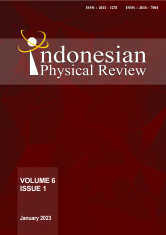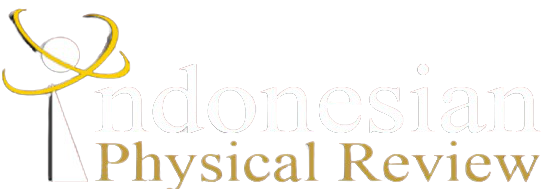ACTIVATED CARBON PREPARED FROM COCONUT SHELL POWDER WITH LOW ACTIVATION TIME AS SUPERCAPACITOR ELECTRODES
DOI:
10.29303/ipr.v6i1.205Downloads
Abstract
In this study, we prepared activated carbon from coconut shell with a low activating time for activated carbon (AC). The coconut shell powder (< 100 µm) allows for an effective pyrolysis process and low activation time (30 min) that reduces the cost of production. The AC has characteristics of micropore with average size of 1.9 nm and a surface area of 460.50 m2/g. For supercapacitor electrode, the AC electrodes have capacitance of 50, 66, and 67.5 F/g when 0.5 M, 1 M, and 2 M of Na2SO4 electrolyte was being inserted, respectively. In addition, the equivalent series resistance (ESR) of the AC electrode was 6.6; 4.3, and 4.1 W for 0.5 M, 1 M and 2 M of Na2SO4 electrolyte. These results indicate that the coconut shell powder can be an alternative source for supercapacitor application with moderate performance.Keywords:
activated carbon coconut shell activation time supercapasitor electrodesReferences
Poonam, K. Sharma, A. Arora, and S.K. Tripathi, “Review of supercapacitors: materials and devices,†J Energy Storage, vol. 21, p. 801-825, 2019, doi.org/10.1016/j.est.2019.01.010.
A. González, E. Goikolea, J.A. Barrena, and R. Mysyk, “Review on supercapacitors: tecnologies and materials, â€Renewable and Sustainable Energy Reviews,†vol. 58, p. 1189-1206, 2016, doi.org/10.1016/j.rser.2015.12.249.
Z.S. Iro, C. Subramani, and S.S Dash, “A Brief Review on Electrode Materials for Supercapacitor,†Int. J. Electrochem. Sci., vol. 11, p. 10628-10643, 2016, doi: 10.20964/2016.12.50.
J. Yin, W. Zhang, N.A. Alhebshi, N. Salah, and H.N. Alshareef, “Synthesis strategies of porous carbon for supercapacitor application,†Small Methods, vol. 4, no. 3, 1900853, 2020, doi.org/10.1002/smtd.201900853.
S. Ghosh, R. Santhosh, S. Jeniffer, V. Raghavan, G. Jacob, K. Nanaji, P. Kollu, S.K. Jeong, and A.N. Grace, “Natural biomass derived hard carbon and activated carbons as electrochemical supercapacitor electrodes,†Scientific Reports, vol. 9, no. 16315, 2019, doi.org/10.1038/s41598-019-52006-x.
P. González-GarcÃa, “Activated carbon from lignocellulosics precursors: A review of the synthesis methods, characterization techniques and applications,†Renew. Sustain. Energy Rev., vol. 82, p. 1393-1414, 2018, doi.org/10.1016/j.rser.2017.04.117.
J. Zhou, A. Luo, and Y. Zhao, “Preparation and characterization of activated carbon from waste tea by physical activation using steam,†Journal of Air & Waste Management Association, vol. 68, no. 12, p. 1269-1277, 2018, doi.org/10.1080/10962247.2018.1460282.
M. Ramón-Gonçalves, L. Alcaraz, S. Pérez-Ferreras, M.E. León-González, N. Rosales- Conrado, and F.A. López,†Extraction of polyphenols and synthesis of new activated carbon from spent coffee grounds,†Scientific Reports, vol. 9, no. 17706, 2019, doi.org/10.1038/s41598-019-54205-y.
H. Lu, and X.S. Zhao, “Biomass-derived carbon electrode materials for supercapacitors,†Sustainable Energy Fuels, vol. 1, issue 6, p. 1265-1281, 2017, doi.org/10.1039/C7SE00099E.
J. Phiri, J. Dou, T. Vuorinen, P.A.C. Gane, and T.C. Maloney, “Highly porous willow wood-derived activated carbon for high performance supercapacitor electrodes,†ACS Omega, vol. 4, p. 18108-18117, 2019, doi: 10.1021/acsomega.9b01977.
T.K. Enock, C.K. King’ondu, A. Pogrebnoi, and Y.A.C. Jande, “Status of biomass derived carbon materials for supercapacitor application,†International Journal of Electrochemistry, 6453420, 2017, doi.org/10.1155/2017/6453420.
A.M. Abioye and F.N. Ani, “Recent development in the production of activated carbon electrodes from agricultural waste biomass for supercapacitors: A review,†Renew. Sustain. Energy Rev., vol. 52, p. 1282-1293, 2015, doi.org/10.1016/j.rser.2015.07.129
D. Das, D.P. Samal, and B.C. Meikap, “Preparation of activated carbon from green coconut shell and its characterization,†J. Chem. Eng Process Technol, vol. 6, Issue 5, 1000248, 2015, doi: 10.4172/2157-7048.1000248.
S.M. Omokafe, A.A. Adeniyi, E.O. Igbafen, S.R. Oke, and P.A. Olubambi, “Fabrication of Activated Carbon from Coconut Shells and its Electrochemical Properties for Supercapacitors,†Int. J. Electrochem. Sci., vol. 15, p. 10854-10865, 2020, doi: 10.20964/2020.11.10.
M. Juan, X.R. Wang, R.J. Fan, W.H. Qu, and W.C. Li, “Coconut-Shell-Based Porous Carbons with a Tunable Micro/Mesopore Ratio for High-Performance Supercapacitors,†Energy Fuels, vol. 26, no. 26, 5321–5329, 2012, doi.org/10.1021/ef3009234.
M. Juan, X.R. Wang, R.J. Fan, W.H. Qu, and W.C. Li, “Coconut-Shell-Based Porous Carbons with a Tunable Micro/Mesopore Ratio for High-Performance Supercapacitors,†Energy Fuels, vol. 26, no. 26, 5321–5329, 2012, doi.org/10.1021/ef3009234.
L. Zhang, X. Hu, Z. Wang, F. Sun, and D.G. Dorrell, “A review of supercapacitor modeling, estimation, and applications: A control/management perspective,†Renew. Sustain. Energy Rev.,†vol. 81, 2018, dx.doi.org/10.1016/j.rser.2017.05.283.
J. Yang, H. Wu, M. Zhu, W. Ren, Y. Lin, H. Chen, and F. Pan, “Optimized mesopores enabling enhanced rate performance in novel ultrahigh surface area meso-/microporous carbon for supercapacitors,†Nano Energy, vol. 33, p. 453-461, 2017, doi.org/10.1016/j.nanoen.2017.02.007.
S.I. Wong, H. Lin, J. Sunarso, B.T. Wong, and B. Jia, “Optimization of ionic-liquid based electrolyte concentration for high-energy density graphene supercapacitors,†Appl. Mater. Today, vol. 18, 100522, 2022, doi.org/10.1016/j.apmt.2019.100522.
J. Bedia, V.M. Monsalvo, J.J. Rodriguez, and A.F. Mohedano,†Iron catalysts by chemical activation of sewage sludge with FeCl3 for CWPO,†Chem. Engineer J, vol. 318, p. 224-230, 2017, doi.org/10.1016/j.cej.2016.06.096.
S. Rold´an, I. Villar, V. Ruı´z, C. Blanco, M. Granda, R. Men´endez, and R. Santamarı´a, “Comparison between electrochemical capacitors based on NaOH- and KOH activated carbonsâ€, Energy Fuels, vol. 24, no. 6 p. 3422–3428, 2010, doi.org/10.1021/ef901538m.
C. Li, W. Wu, P. Wang, W. Zhou, J. Wang, Y. Chen, L. Fu, Y. Zhu, Y. Wu, and W. Huang, “Fabricating an aqueous symmetric supercapacitor with a stable high working voltage of 2 V by using an alkaline-acidic electrolyte, Advanced Science, vol. 6, Issue 1, 1801665, 2019, doi.org/10.1002/advs.201801665.
M. Sivachidambaram, J.J. Vijaya, K. Niketha, L.J. Kennedy, E. Elanthamilan, and J.P. Merlin, “Electrochemical studies on tamarindus indica fruit shell bio-waste derived nanoporous activated carbons for supercapacitor application,†J Nanosci Nanotechnol., vol. 19, no. 6, p. 3388-3397, 2019, doi: 10.1166/jnn.2019.16115.
K.S.W. Sing, “Physisorption of nitrogen by porous materials, Journal of Porous Materials, vol. 2, p. 5-8, 1995, https://doi.org/10.1007/BF00486564.
X. Song, X. Ma, Y. Li, L. Ding, and R. Jiang, “Tea waste derived microporous active carbon with enhanced double-layer supercapacitor behaviors, “ Appl. Surf. Sci., vol. 487, p. 189-197, 2019, doi.org/10.1016/j.apsusc.2019.04.277.
Z. Xu, Z. Yuan, D. Zhang, W. Chen, Y. Huang, T. Zhang, D. Tian, H. Deng, Y. Zhou, and Z. sun, “Highly mesoporous activated carbon synthesized by pyrolysis of waste polyester textiles and MgCl2: Physiochemical characteristics and pore-forming mechanism,†J. Clean. Prod., vol. 192, p. 453-461, 2018, doi.org/10.1016/j.jclepro.2018.05.007.
Z. Xu, Z. Yuan, D. Zhang, W. Chen, Y. Huang, T. Zhang, D. Tian, H. Deng, Y. Zhou, and Z. sun, “Highly mesoporous activated carbon synthesized by pyrolysis of waste polyester textiles and MgCl2: Physiochemical characteristics and pore-forming mechanism,†J. Clean. Prod., vol. 192, p. 453-461, 2018, doi.org/10.1016/j.jclepro.2018.05.007.
L. Su, Q. Zhang, Y. Wang, J. Meng, Y. Xu, L. Liu, and X. Yan, “Achieving a 2.7 V aqueous hybrid supercapacitor by the pH-regulation of electrolyte, J. Mater. Chem. A., vol. 8, issue 17, p. 8648-8660, 2020, doi.org/10.1039/D0TA02926B.
License

This work is licensed under a Creative Commons Attribution-NonCommercial-ShareAlike 4.0 International License.
Authors who publish with Indonesian Physical Review Journal, agree to the following terms:
- Authors retain copyright and grant the journal right of first publication with the work simultaneously licensed under a Creative Commons Attribution-ShareAlike 4.0 International Licence (CC BY SA-4.0). This license allows authors to use all articles, data sets, graphics, and appendices in data mining applications, search engines, web sites, blogs, and other platforms by providing an appropriate reference. The journal allows the author(s) to hold the copyright without restrictions and will retain publishing rights without restrictions.
- Authors are able to enter into separate, additional contractual arrangements for the non-exclusive distribution of the journal's published version of the work (e.g., post it to an institutional repository or publish it in a book), with an acknowledgment of its initial publication in Indonesian Physical Review Journal.
- Authors are permitted and encouraged to post their work online (e.g., in institutional repositories or on their website) prior to and during the submission process, as it can lead to productive exchanges, as well as earlier and greater citation of published work (See The Effect of Open Access).





